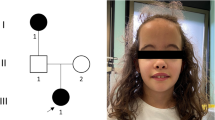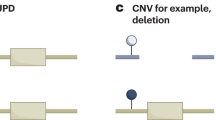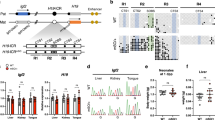Abstract
Silver-Russell syndrome (SRS, OMIM 180860) is a congenital disorder characterized by severe intrauterine and postnatal growth retardation, dysmorphic facial features and body asymmetry. SRS is genetically heterogenous with maternal uniparental disomy with respect to chromosome 7 occurring in ∼10% of affected individuals. Given the crucial role of the 11p15 imprinted region in the control of fetal growth, we hypothesized that dysregulation of genes at 11p15 might be involved in syndromic intrauterine growth retardation. We identified an epimutation (demethylation) in the telomeric imprinting center region ICR1 of the 11p15 region in several individuals with clinically typical SRS. This epigenetic defect is associated with, and probably responsible for, relaxation of imprinting and biallelic expression of H19 and downregulation of IGF2. These findings provide new insight into the pathogenesis of SRS and strongly suggest that the 11p15 imprinted region, in addition to those of 7p11.2-p13 and 7q31-qter, is involved in SRS.
This is a preview of subscription content, access via your institution
Access options
Subscribe to this journal
Receive 12 print issues and online access
$209.00 per year
only $17.42 per issue
Buy this article
- Purchase on SpringerLink
- Instant access to full article PDF
Prices may be subject to local taxes which are calculated during checkout




Similar content being viewed by others
Accession codes
References
DeChiara, T.M., Efstratiadis, A. & Robertson, E.J. A growth-deficiency phenotype in heterozygous mice carrying an insulin-like growth factor II gene disrupted by targeting. Nature 345, 78–80 (1990).
Fitzpatrick, G.V., Soloway, P.D. & Higgins, M.J. Regional loss of imprinting and growth deficiency in mice with a targeted deletion of KvDMR1. Nat. Genet. 32, 426–431 (2002).
Leighton, P., Ingram, R., Eggenswiler, J., Efstratiadis, A. & Tilghman, S. Disruption of imprinting caused by deletion of the H19 gene region in mice. Nature 375, 34–39 (1995).
Sun, F., Dean, W., Kelsey, G., Allen, N. & Reik, W. Transactivation of IGF2 in a mouse model of Beckwith-Wiedemann syndrome. Nature 389, 809–815 (1997).
Gaston, V. et al. Analysis of the methylation status of the KCNQ1OT and H19 genes in leukocyte DNA for the diagnosis and prognosis of Beckwith-Wiedemann syndrome. Eur. J. Hum. Genet. 9, 409–418 (2001).
Price, S.M., Stanhope, R., Garrett, C., Preece, M.A. & Trembath, R.C. The spectrum of Silver-Russell syndrome: a clinical and molecular genetic study and new diagnostic criteria. J. Med. Genet. 36, 837–842 (1999).
Hitchins, M.P., Stanier, P., Preece, M.A. & Moore, G.E. Silver-Russell syndrome: a dissection of the genetic aetiology and candidate chromosomal regions. J. Med. Genet. 38, 810–819 (2001).
Hannula, K., Kere, J., Pirinen, S., Holmberg, C. & Lipsanen-Nyman, M. Do patients with maternal uniparental disomy for chromosome 7 have a distinct mild Silver-Russell phenotype? J. Med. Genet. 38, 273–278 (2001).
Fisher, A.M. et al. Duplications of chromosome 11p15 of maternal origin result in a phenotype that includes growth retardation. Hum. Genet. 111, 290–296 (2002).
Eggermann, T. et al. Is maternal duplication of 11p15 associated with Silver-Russell syndrome? J. Med. Genet. 42, e26 (2005).
Obermann, C. et al. Searching for genomic variants in IGF2 and CDKN1C in Silver-Russell syndrome patients. Mol. Genet. Metab. 82, 246–250 (2004).
Meyer, E., Wollmann, H.A. & Eggermann, T. Analysis of genomic variants in the KCNQ1OT1 transcript in Silver-Russell syndrome patients. Mol. Genet. Metab. 84, 376–377 (2005).
Murrell, A. et al. An intragenic methylated region in the imprinted Igf2 gene augments transcription. EMBO Rep. 2, 1101–1106 (2001).
Engel, N., West, A.G., Felsenfeld, G. & Bartolomei, M.S. Antagonism between DNA hypermethylation and enhancer-blocking activity at the H19 DMD is uncovered by CpG mutations. Nat. Genet. 36, 883–888 (2004).
Bell, A.C. & Felsenfeld, G. Methylation of a CTCF-dependent boundary controls imprinted expression of the Igf2 gene. Nature 405, 482–485 (2000).
Hark, A.T. et al. CTCF mediates methylation-sensitive enhancer-blocking activity at the H19/Igf2 locus. Nature 405, 486–489 (2000).
Kanduri, C. et al. The 5′ flank of mouse H19 in an unusual chromatin conformation unidirectionally blocks enhancer-promoter communication. Curr. Biol. 10, 449–457 (2000).
Schoenherr, C.J., Levorse, J.M. & Tilghman, S.M. CTCF maintains differential methylation at the Igf2/H19 locus. Nat. Genet. 33, 66–69 (2003).
Fedoriw, A.M., Stein, P., Svoboda, P., Schultz, R.M. & Bartolomei, M.S. Transgenic RNAi reveals essential function for CTCF in H19 gene imprinting. Science 303, 238–240 (2004).
Murrell, A., Heeson, S. & Reik, W. Interaction between differentially methylated regions partitions the imprinted genes Igf2 and H19 into parent-specific chromatin loops. Nat. Genet. 36, 889–893 (2004).
Reik, W. et al. Imprinting mutations in the Beckwith-Wiedemann syndrome suggested by altered imprinting pattern in the IGF2–H19 domain. Hum. Mol. Genet. 4, 2379–2385 (1995).
Weksberg, R. et al. Discordant KCNQ1OT1 imprinting in sets of monozygotic twins discordant for Beckwith-Wiedemann syndrome. Hum. Mol. Genet. 11, 1317–1325 (2002).
Sparago, A. et al. Microdeletions in the human H19 DMR result in loss of IGF2 imprinting and Beckwith-Wiedemann syndrome. Nat. Genet. 36, 958–960 (2004).
Schneid, H. et al. Parental allele specific methylation of the human insulin-like growth factor II gene and Beckwith-Wiedemann syndrome. J. Med. Genet. 30, 353–362 (1993).
Brannan, C., Dees, E., Ingram, R. & Tilghman, S. The product of the H19 gene may function as an RNA. Mol. Cell. Biol. 10, 28–36 (1990).
Frevel, M.A., Sowerby, S.J., Petersen, G.B. & Reeve, A.E. Methylation sequencing analysis refines the region of H19 epimutation in Wilms tumor. J. Biol. Chem. 274, 29331–29340 (1999).
Grunau, C., Clark, S. & Rosenthal, A. Bisulfite genomic sequencing: systematic investigation of critical experimental parameters. Nucleic Acids Res. 29, E65–5 (2001).
Dupont, J.M., Tost, J., Jammes, H. & Gut, I.G. De novo quantitative bisulfite sequencing using the pyrosequencing technology. Anal. Biochem. 333, 119–127 (2004).
Ulaner, G.A. et al. CTCF binding at the insulin-like growth factor-II (IGF2)/H19 imprinting control region is insufficient to regulate IGF2/H19 expression in human tissues. Endocrinology 144, 4420–4426 (2003).
Corpechot, C. et al. Hypoxia-induced VEGF and collagen I expressions are associated with angiogenesis and fibrogenesis in experimental cirrhosis. Hepatology 35, 1010–1021 (2002).
Acknowledgements
We thank A. Munnich for providing skin fibroblasts from a control subject and J.-P. Siffroi for culture fibroblasts from individuals with SRS. This work was supported by Pharmacia-Pfizer and Pierre Chatelain, INSERM U515, Université Pierre et Marie Curie and Assistance Publique Hôpitaux de Paris. S.R. was a recipient of NovoNordisk France.
Author information
Authors and Affiliations
Corresponding author
Ethics declarations
Competing interests
The authors declare no competing financial interests.
Supplementary information
Supplementary Table 1
Clinical and molecular characteristics of patients with Silver-Russell syndrome. (PDF 58 kb)
Supplementary Table 2
Primer sequences. (PDF 40 kb)
Rights and permissions
About this article
Cite this article
Gicquel, C., Rossignol, S., Cabrol, S. et al. Epimutation of the telomeric imprinting center region on chromosome 11p15 in Silver-Russell syndrome. Nat Genet 37, 1003–1007 (2005). https://doi.org/10.1038/ng1629
Received:
Accepted:
Published:
Issue Date:
DOI: https://doi.org/10.1038/ng1629



